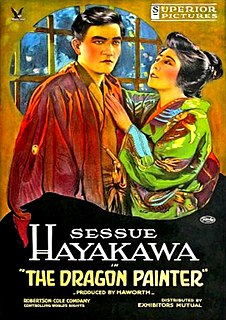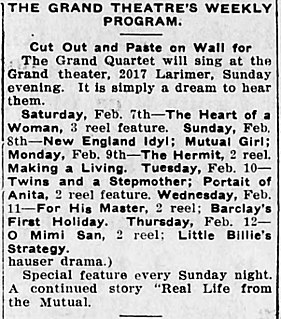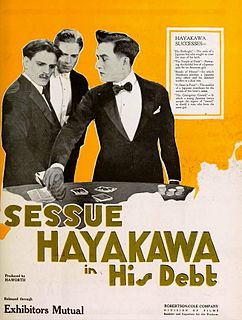Related Research Articles

The cinema of Japan has a history that spans more than 100 years. Japan has one of the oldest and largest film industries in the world; as of 2021, it was the fourth largest by number of feature films produced. In 2011 Japan produced 411 feature films that earned 54.9% of a box office total of US$2.338 billion. Films have been produced in Japan since 1897, when the first foreign cameramen arrived.

Kintarō Hayakawa, known professionally as Sessue Hayakawa, was a Japanese actor and a matinée idol. He was one of the most popular stars in Hollywood during the silent film era of the 1910s and early 1920s. Hayakawa was the first actor of Asian descent to achieve stardom as a leading man in the United States and Europe. His "broodingly handsome" good looks and typecasting as a sexually dominant villain made him a heartthrob among American women during a time of racial discrimination, and he became one of the first male sex symbols of Hollywood.

The Dragon Painter is a 1919 English language silent romance drama film. It is based on the novel of the same name, written by Mary McNeil Fenollosa. It stars Sessue Hayakawa as a young painter who believes that his fiancée, is a princess who has been captured and turned into a dragon. It was directed by William Worthington and filmed in Yosemite Valley, Yosemite National Park, and in the Japanese Tea Garden in Coronado, California.

Souls on the Road is a 1921 Japanese silent film directed by Minoru Murata. Film critic Mark Cousins wrote that it was "the first landmark film in Japanese history".

The Wrath of the Gods is a 1914 American silent drama film directed by Reginald Barker and starring Sessue Hayakawa, Tsuru Aoki, Frank Borzage, Thomas Kurihara and Henry Kotani. This was the first feature film appearance of Hayakawa and the directorial debut of Barker.

O Mimi San is a 1914 American short silent drama film directed by Charles Miller, featuring Tsuru Aoki in the title role and Sessue Hayakawa, Kisaburo Kurihara, Chick Morrison and George Osborne in pivotal roles. It was preserved in 1995.
A Relic of Old Japan is a 1914 American silent short drama film directed by Reginald Barker and Thomas H. Ince. Sessue Hayakawa, Tsuru Aoki, Frank Borzage and Henry Kotani played important roles in the film.
The Beckoning Flame is a 1915 American silent drama film directed by Charles Swickard and featuring Henry Woodruff, Tsuru Aoki, and Rhea Mitchell in pivotal roles.

Sessue Hayakawa: Silent Cinema and Transnational Stardom is a biography of actor Sessue Hayakawa, written by Daisuke Miyao, assistant professor of film at the University of Oregon, and published by Duke University Press. It won the 2007 Book Award in History from the Association of Asian American Studies and the John Hope Franklin Book Award from Duke University (2007).

Ozu's Anti-Cinema is a 1998 book written by Yoshishige Yoshida, translated into English in 2003, and published by Center for Japanese Studies, University of Michigan. It included analysis and commentary on Yasujirō Ozu's films and film-making techniques.

The Village 'Neath the Sea is a 1914 American silent short adventure film directed by Thomas H. Ince and Jay Hunt. Sessue Hayakawa, Tsuru Aoki, Lone Bear and Ernest Swallow played important roles in it.
Sen Yan's Devotion is a 1924 British drama film directed and written by A.E. Coleby. Sessue Hayakawa, Tsuru Aoki, Fred Raynham, Jeff Barlow and Tom Coventry featured in the film.

His Debt is a 1919 American silent drama film directed by William Worthington and produced by Haworth Pictures Corporation.

The Illustrious Prince is a 1919 American drama film directed by William Worthington and produced by Sessue Hayakawa's Haworth Pictures Corporation.
The Aesthetics of Shadow: Lighting and Japanese Cinema is a 2013 book written by Daisuke Miyao. As the title suggests, the book is based on the cinema of Japan.
Daisuke Miyao is a professor of Japanese films at the University of Oregon and the University of California San Diego. He is also the author of Sessue Hayakawa: Silent Cinema and Transnational Stardom and The Aesthetics of Shadow: Lighting and Japanese Cinema, editor of Oxford Handbook of Japanese Cinema and co-translator of Ozu's Anti-Cinema.
The Weavers of Nishijin, also known in English simply as Nishijin, is a 1961 Japanese short documentary film directed by Toshio Matsumoto. It starred Hideo Kanze as a Noh player. Film scholar Mitsuyo Wada-Marciano has written that the film's "depiction of a craftsmen's forced life in the traditional textile trade of Kyoto discloses the multiplicity of the Japanese as well as offering an instance to contemplate the role of cinema as the most popular culture at that time."
"Sendō Kouta" is a Japanese kayōkyoku song originally published as sheet music in 1921 under the common name of "Karesusuki", receiving its current title in 1922. The lyrics were written by Ujō Noguchi and the melody was composed by Shinpei Nakayama. It was popular throughout Japan from at least 1921 to 1923.

The Ghost Cat of Otama Pond is a 1960 Japanese horror film directed and co-written by Yoshihiro Ishikawa, in his directorial debut. Produced by Shintoho, it belongs to the subgenre of "ghost cat" films, featuring a cat-like supernatural entity.
References
- ↑ Sharp, Jasper (August 2014). "The Oxford Handbook of Japanese Cinema". The Times Literary Supplement. London: 38.
- ↑ Amit, Rea (December 2014). "HomeBook Reviews Rewriting Japanese Cinema for the Global Age: The Oxford Handbook of Japanese Cinema by Daisuke Miyao (ed.)". Sense of Cinema (73). Retrieved 3 March 2015.
- ↑ Wroot, Jonathan (2015). "The Oxford Handbook of Japanese Cinema, edited by Daisuke Miyao / East Asian Film Stars, edited by Leung Wing-Fai and Andy Willis". Journal of Japanese and Korean Cinema. 7 (2): 167–170. doi:10.1080/17564905.2015.1087155. ISSN 1756-4905.